- 1 hour ago
- Middle East
The Egyptian military has released images of items found during the search in the Mediterranean Sea for missing Egypt Air flight MS804.
They include life vests, parts of seats and objects clearly marked EgyptAir.
The Airbus A320 was en route from Paris to Cairo with 66 people aboard when it vanished from radar early on Thursday.
Investigators have confirmed smoke was detected in various parts of the cabin three minutes before it disappeared, but say the cause is still not known.
Speaking on Saturday after meeting relatives of victims, French Foreign Minister Jean-Marc Ayrault said "all theories are being examined and none is favoured".
- Who were the victims?
- The problem with fires on planes
- The passenger who almost missed the flight
- The internet fakes and rumours
Images posted on the Facebook page of the spokesman for the Egyptian Armed Forces showed life vests and other items with the EgyptAir logo.
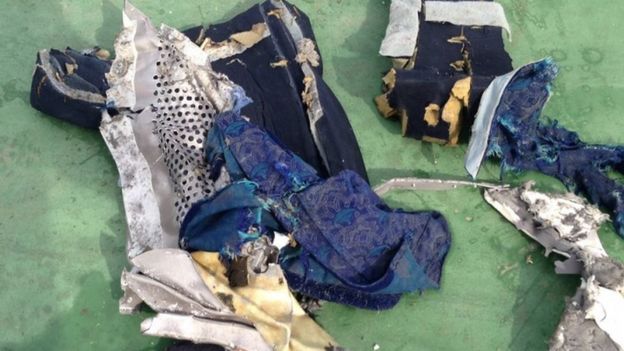 EGYPTIAN ARMED FORCES
EGYPTIAN ARMED FORCES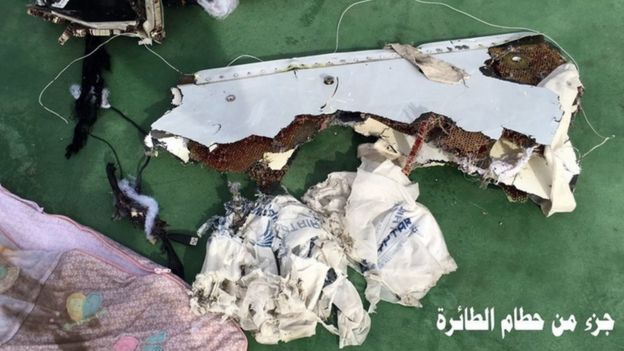 EGYPTIAN ARMED FORCES
EGYPTIAN ARMED FORCES AFP
AFP
The search has also reportedly found body parts and luggage.
The main body of the plane and the two "black boxes" which show flight data and cockpit transmissions have not yet been located.
While no bodies have been recovered, memorials have been taking place for the victims.
A service was held in a Cairo church on Saturday for air hostess Yara Hani, who was aboard the doomed plane.
Smoke alarms
The Aviation Herald said that smoke detectors had gone off in the toilet and the aircraft's electronics before the signal was lost.
It said it had received flight data filed through the Aircraft Communications Addressing and Reporting System (ACARS) from three independent channels.
It said the system showed that at 02:26 local time on Thursday (00:26 GMT) smoke was detected in the jet's toilet.
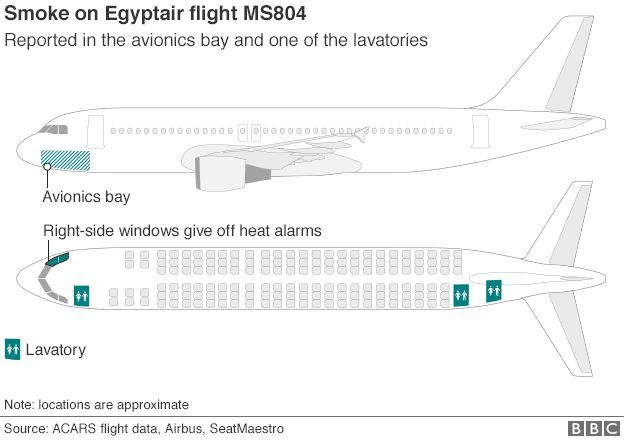
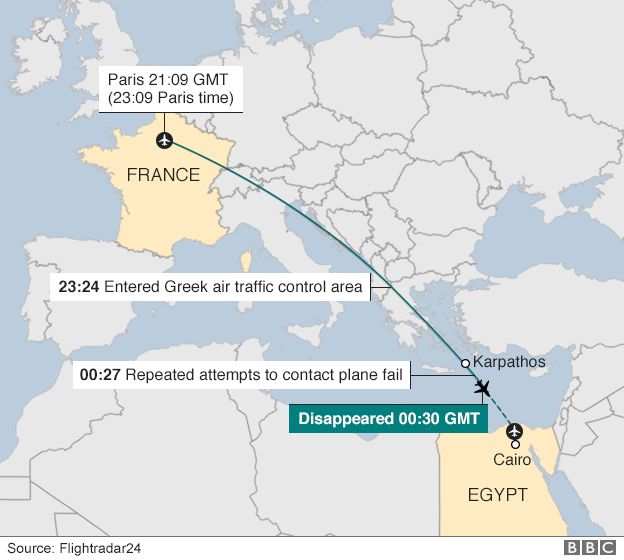
A minute later - at 00:27 GMT - there was an avionics alert indicating smoke in the bay below the cockpit that contains aircraft electronics and computers.
The last ACARS message was at 00:29 GMT, the air industry website said, and the contact with the plane was lost four minutes later at 02:33 local time.
ACARS is used to routinely download flight data to the airline operating the aircraft.
Confirming the data, France's Bureau of Investigations and Analysis told AFP it was "far too soon to interpret and understand the cause of the accident as long as we have not found the wreckage or the flight data recorders".
Agency spokesman Sebastien Barthe told Associated Press the messages "generally mean the start of a fire" but added: "We are drawing no conclusions from this. Everything else is pure conjecture."
Philip Baum, the editor of Aviation Security International Magazine, told the BBC that technical failure could not be ruled out.
"There was smoke reported in the aircraft lavatory, then smoke in the avionics bay, and over a period of three minutes the aircraft's systems shut down, so you know, that's starting to indicate that it probably wasn't a hijack, it probably wasn't a struggle in the cockpit, it's more likely a fire on board."
Analysis: Richard Westcott, BBC transport correspondent
This data could be the biggest clue yet as to what happened. It suggests there was a fire at the front of the aircraft, on the right-hand side.
The sequence begins with a warning of an overheating window in the cockpit. Smoke is then detected in the lavatory (we assume it's the one behind the cockpit) and in a bay right underneath the cockpit, which is full of electronic equipment.
Finally, another window becomes too hot, before all the systems begin collapsing. All of this takes place over a few minutes, then the aircraft drops off the radar.
Some pilots have suggested that the 90 degree left turn the plane then made is a known manoeuvre to get out of the way in an emergency, when an aircraft needs to drop height suddenly.
The 360 degree turn after that, they say, could be the crew managing a crisis.
So it seems that the aircraft caught fire and that the fire spread very quickly. But whether that fire was deliberate or mechanical, we still can't say.
Security consultant Sally Leivesley said the timing on the data suggested an "extremely rapidly developing flame front from a fire that has overwhelmed the avionics very, very quickly".
She cited the case of "underpants bomber" Umar Farouk Abdulmutallab, who tried to set off an explosive device hidden in his underwear on a Detroit-bound flight in 2009.
Although the attempt failed, a fire from the device's chemicals still spread "right up the side of the plane".
Greece says radar shows the Airbus A320 making two sharp turns and dropping more than 25,000ft (7,620m) before plunging into the sea.
The search is now focused on finding the plane's flight recorders, in waters between 2,500 and 3,000 metres deep.
In October, an Airbus A321 operated by Russia's Metrojet blew up over Egypt's Sinai Peninsula, with all 224 people on board killed.
Sinai Province, a local affiliate of the Islamic State jihadist group, said it had smuggled a bomb on board.
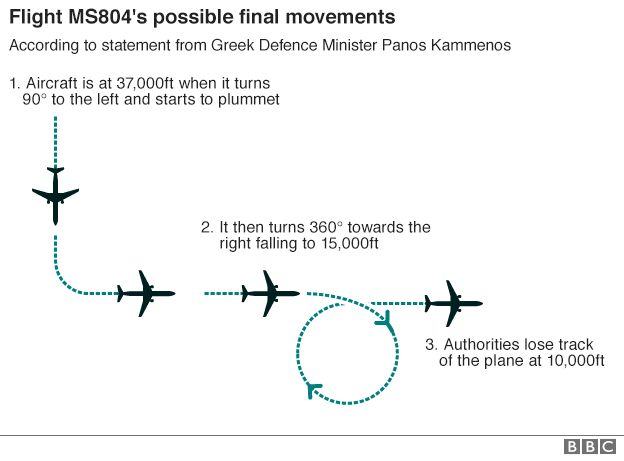
If anyone is concerned about relatives or friends following the disappearance of the flight, they can call this free number provided by EgyptAir: +202 259 89320

No comments:
Post a Comment